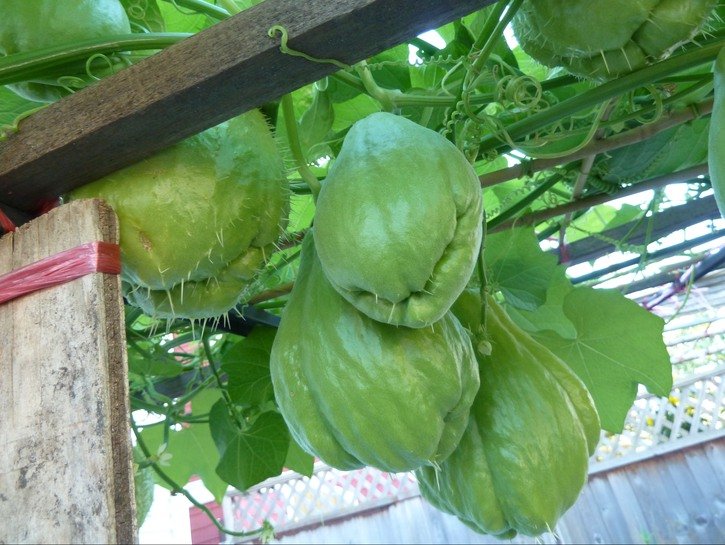What Is Chayote?
Chayote (pronounced chahy-oh-tee), also known as mirliton, is a pale green, pear-shaped squash between 10 and 20 centimeters long. Although it’s a fruit, it’s more often used as a vegetable. The chayote has a single, generous pit surrounded by edible flesh and rind. While the skin is edible, many people prefer to discard it because of its firm texture.
Origin

The chayote is a tropical fruit and a part of the gourd family. This unique squash is native to Mexico, but it’s now farmed and enjoyed in a variety of places around the world. Chayote is a favorite ingredient in many Central American dishes.
Taste And Texture

The flesh of the chayote is mild in flavor and subtly sweet like butternut squash or pumpkin. The texture of the squash’s flesh is somewhere between the texture of a potato’s flesh and the texture of a cucumber’s.
Nutritional Value

Chayote is an exceptionally healthy food and would be an excellent addition to your diet if you can get your hands on it! Like other gourds, including the pumpkin, it is low in calories (just 25 calories per cup), and it contains no saturated fats or cholesterol. Additionally, chayote is jam-packed with:

Fiber
Chayote is a valuable source of dietary fiber. Because it is a low-calorie and fiber-dense fruit, medical professionals recommend it as a way to control cholesterol levels and lose weight.
Vitamins
Chayotes are an outstanding source of the B vitamin folate. One hundred grams of chayote contain 23 percent of an individual’s recommended daily intake. Folate is crucial for cell division and DNA synthesis. When folate is taken appropriately before pregnancy and during early pregnancy, it can help inhibit neural tube defects in newborn babies.
Aside from folate, chayotes contain the B vitamins thiamin and riboflavin, which help the body convert carbohydrates into energy.
Chayote is also a great source of vitamin C, an important antioxidant, and vitamin K, which helps your blood clot and keeps your bones strong.
Minerals
Chayotes are also rich in minerals like iron, manganese, phosphorus, zinc, copper, and potassium. Potassium is key in reducing the risk of hypertension. Manganese contributes to a healthy nervous and skeletal system, and zinc and copper boost your immune system.
Where To Find It

The chayote is available for purchase in most markets in the southern United States from October to April. In other parts of the U.S., you may only find the squash at specialty markets carrying Mexican and/or Central American cuisine.
When selecting a chayote, look for one that is firm to the touch, brilliant green in color, and has a smooth or prickly surface. If the chayote has wrinkles, that is fine, as long as it still has smooth skin. If the skin is noticeably movable, it’s best to choose another.
How To Prepare It

Begin by washing your chayote thoroughly under cold running water. Make sure all debris is removed. Then trim both stem ends and bases with a knife and discard them.
If your squash is small and young, it is not necessary to peel the skin. However, if it is a bigger squash, it may need some light peeling. Beware that your skin my be irritated by the sticky substance that chayote produces. To protect your hands, peel the chayote under cold running water or wear a pair of gloves.
5 Amazingly Delicious Chayote Dishes
The mild flavor of the chayote makes it an ideal ingredient to cook with, since it takes on the taste profile of any dish that you’re preparing. It’s incredibly versatile in both sweet and savory dishes. The chayote can also be used as a healthy alternative to other ingredients.
Sautéed Chayote And Potatoes With Shallots And Mint

If you’re new to cooking with chayote, try this recipe first before challenging yourself with something more complex. This dish consists of inexpensive, accessible ingredients, and the chayote is the star of the show. Don’t let the simplicity of this recipe fool you. The flavors of shallot, garlic, and mint united with chayote will undoubtedly delight!
Chayote Cobbler

Those on the ketogenic diet, rejoice! Chayotes are excellent substitutes for apples, and they will make a lovely addition to your holiday dishes. The chayote has an apple-like texture, and if you add a little no-calorie sweetener and a little lemon to it, it can taste like an apple, too. If you find that hard to believe, just try this dish. The filling in this cobbler is versatile; you could easily use it in keto pie with an almond flour crust.
Chayote With Chorizo And Shrimp

This simple and tasty six-ingredient recipe is low in carbohydrates, since it uses chayote instead of noodles to soak up the robust chorizo flavor. If you don’t have a noodle spiralizer, we recommend that you get one so that you can start making this for dinner!
Cream Of Chayote Soup

Winter is coming! You know what that means: soup season. There is no better reason to try out this recipe for cream of chayote soup. The combination of chicken broth, butter, milk, and chayote makes for a deliciously creamy soup that will warm the soul.
Greens And Chayote Enchiladas With Salsa Verde

If you’re looking for a lighter enchilada option, chayote would be a great alternative to meat. Chayote eliminates some of the heaviness that this classic dish is known for but doesn’t compromise on flavor. Although it is more challenging to prepare, this fantastic dish will not fail to impress.
If you get a chance to pick up this squash at your local grocer or specialty food market, try one of the recipes listed above and let us know what you think.
